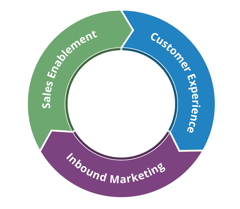Analytics are critical for you to understand better the success of your social media content, lead generation, e-mail campaigns, website traffic, and marketing. There's a wealth of important information from analytics, but you must first understand why you should be using analytics and how to use your analytical tools effectively.
Here are three simple ways that you can use analytics to optimize your marketing campaigns:
- Social Media Marketing—By analyzing your social media content on Twitter, Facebook, LinkedIn, and any other channel your business is active on, you will get a much clearer understanding of what content is having the most impact on your followers. You can also determine which content is generating the most activity and whether there are any specific offers that entice followers to click and continue down the marketing conversion funnel.
Here is a quick example of getting a snapshot of your social media analytics from HubSpot. The graph below shows traffic to your website from social media, and you can drill down further to see which social site brought the most traffic.
- Website Traffic – Using analytics will help you better understand the effectiveness of your website’s navigation, content, placement of calls-to-action, and more. Analytics show you the percentage of visitors who aren’t navigating past the homepage, which landing pages have the highest conversion rates, or which keywords generate the most new leads. If you use HubSpot, there are many ways to "slice and dice" your analytics to ensure you are making the most of the tools available.
From there, you can focus more on particular keywords when writing your website content to generate more leads. Or you can build specific “calls to action” on the homepage to get visitors to explore the rest of the website based on their buyer persona. A website should be a conversion center for your prospects, allowing them to download, contact, and move through the content in an organized fashion. Your website should provide prospects with the content they need, when they need it.
Below is an example of how you can analyze your website traffic. This HubSpot graph showcases website traffic by week. The different colors showcase whether traffic is coming to your site from organic search, direct traffic, social media, referral links, or email marketing. To the right, you can see the actual number of visits from each main website traffic driver.


- Email Campaign Effectiveness – You can also use analytics to look at open rates, click-through rates, and even the dreaded unsubscribe. This helps you understand which email campaigns successfully generated the most leads. You can then apply the analytics and data from these successes to test future campaigns to achieve similar results. Analytics will also identify areas of opportunity to improve future campaigns.
In the HubSpot snapshot below, you can see an example from an email campaign that showcases its effectiveness. This gives you a quick glance at the email open rate, delivery rate, and click rate.
You can see there is quite a bit of information in analytics, but sometimes it can be quite overwhelming to use. You don't need to spend hours each week using your analytical tools, but you should try to find the right metrics to track the success of your marketing campaigns. This will help you find the right conversion opportunities for your sales and marketing pipeline.
We invite you to download our complimentary marketing planning template to help you strategically identify your goals and find the most effective ways to understand your analytics. In addition, if you are looking for ways to optimize your marketing and analyze your campaigns effectively, we are offering you a complimentary 30-day trial of HubSpot, the all-in-one inbound marketing tool.


__Square.png?width=250&height=250&name=Marketing_Hub_(1)__Square.png)




.png?width=250&name=diamond-badge-color%20(1).png)
